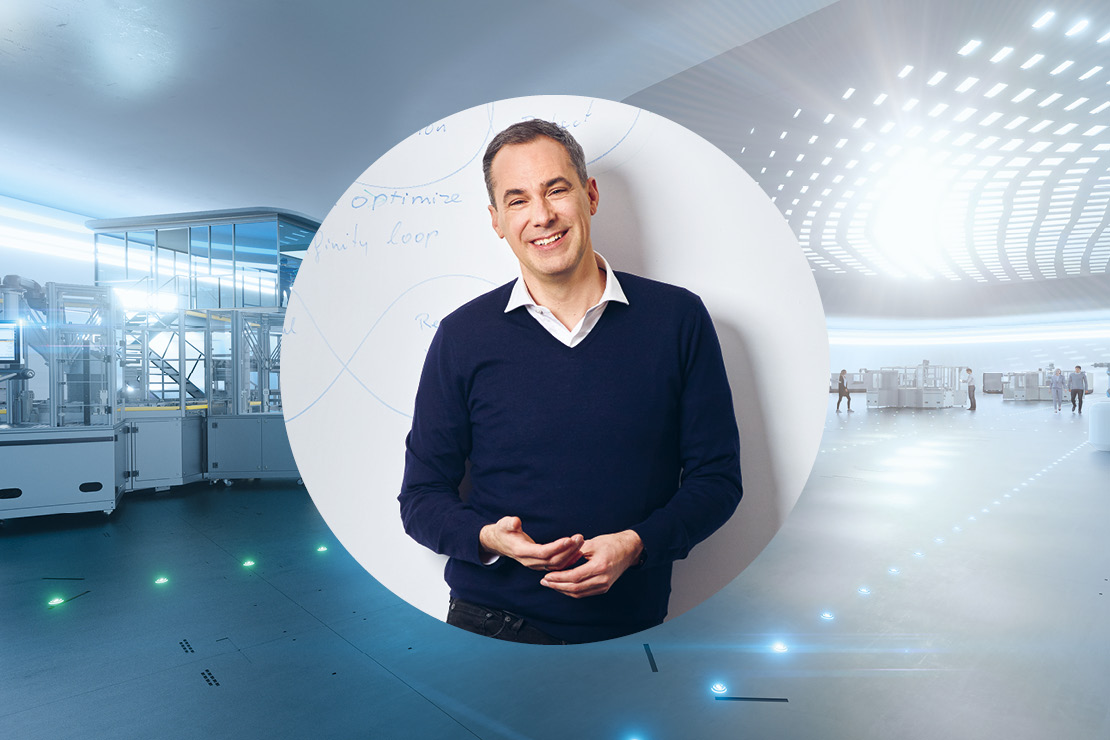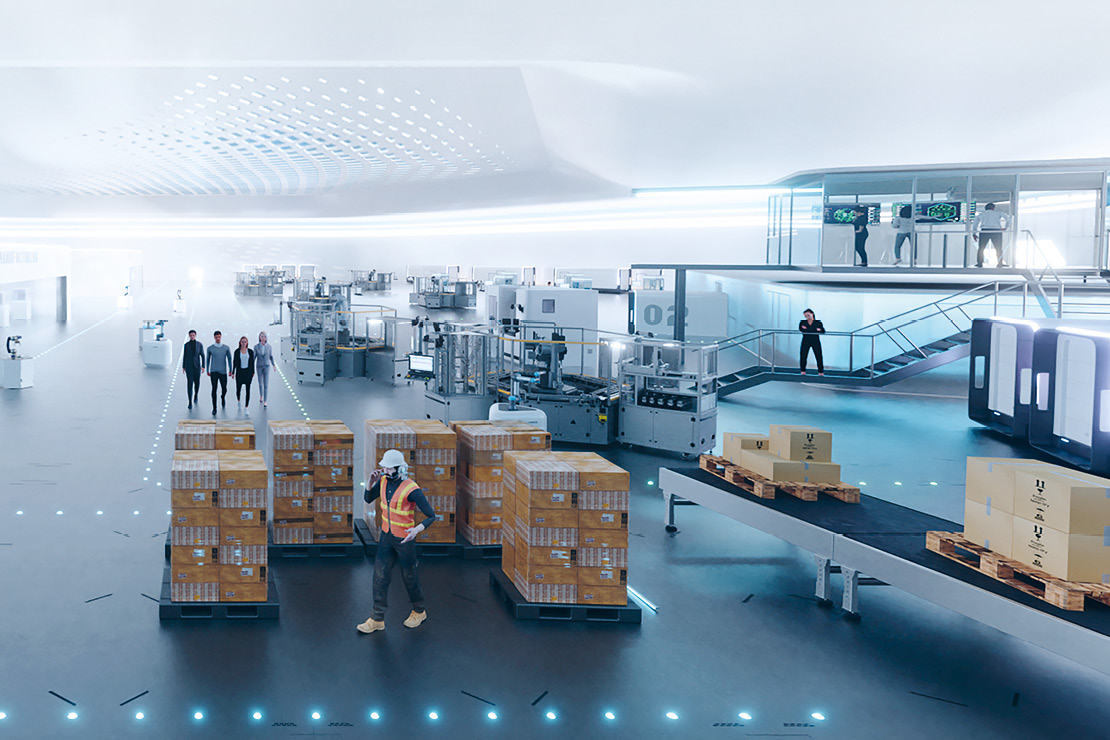
Siemens AG
In dialog with Cedrik Neike
Member of the Managing Board of Siemens AG and CEO of Digital Industries
Mr Neike, AI has been one of the defining news topics for over a year. Is AI a turning point for industry?
Without a doubt. And not only for industry. Our world is in the middle of a huge transformation. Whether you look at Japan, Italy, Germany, the United States or even China, in most parts of the world we see an aging population. We see a skilled worker shortage in almost every country in the world. At the same time, we see a trend that we call glocalization. Production is moving closer to the end customer. And on top of that we are going through the sustainability transformation of industry, of economy, of our society. To tackle these megatrends, we need to become much more efficient, much more flexible, and we need to do this really, really fast. We’re going to need every little bit of human ingenuity, creativity and power we can get to master these transformations. With AI we have an extremely powerful tool that can help us, a supercharger for the digital transformation. AI and especially industrial AI has taken off right on time.
You are referring to the boom of generative AI?
Generative AI brings about a paradigm shift, especially for industries. For this to be possible, three things had to happen. First: the transformer model had to be invented. This is a deep-learning architecture that can understand context and relationships within data. Second: We needed huge amounts of high-quality data to train these models. Third: We needed a lot of computing power. There is no AI without powerful chips. All this is available today.
Generative AI changes the way we communicate and interact with machines. In the past we had to learn a programming language to communicate with machines. And we had to be very specific. With generative AI we can simply talk to computers and machines in our own language. And the machines can answer us. We have a completely new user interface. And the last new user interface – the touch screen – changed our world. I am convinced that AI will have an even bigger impact.
At this year’s Hannover Fair, you announced the Siemens Industrial Copilot. Can you explain what this is about?
Our Siemens Industrial Copilot will work as a translator between humans and machines. It can, for example, generate and optimize code for PLCs, the brains of production machines. And we have taught Siemens Industrial Copilot our documentation, our manuals, our guidelines. So, it can help with troubleshooting as well. I first started my apprenticeship at Siemens in the 90s. Back then whenever there was a machine malfunction you had to find a technician. Or, if it was more complicated, you had to get a service technician from the specific machine builder on the phone to help you out. And there was a lot of time pressure, because every second of standstill costs a lot of money. In many factories this is still a challenge today. In the future you will simply be able to ask the Industrial Copilot. And it will even answer you in the middle of the night.
We developed the Siemens Industrial Copilot – together with Microsoft – to help automation and maintenance experts on the shop floor. Our vision is to have a copilot for all industries that can support factory workers, engineers, everyone.
You mentioned industrial AI earlier. What does that mean?
In industry we talk about industrial AI. You can’t simply put consumer AI on the shopfloor. Think of it that way: If ChatGPT hallucinates and makes a mistake in your kids’ homework, it is annoying. If an AI makes a mistake in a production line, while autonomously driving a tram or during a medical diagnosis, there could be very serious consequences. It could cost huge amounts of money. And it could be outright dangerous.
This is why we invest heavily in R&D. Today we have almost 3000 patent families in AI, almost 3 times as much as our competitors in industry. At Siemens more than 1500 AI experts are working on making AI industrial-grade. They make sure that the AI applications we offer for industrial use are reliable. When you ask AI something, it needs to give you the same answer every time. No matter where or how it is used. It needs to be robust, secure, and trustworthy. We need to understand where the data is coming from and what kind of biases are in there. But even then: We will always need a human in the loop. We can’t simply leave the machines alone. We are talking about a copilot, not an autopilot.
This sounds really mind blowing. How is AI used in industry?
In industry, AI is much more than just generative AI. A modern factory can generate up to 2200 terabytes of data each month. This is the equivalent of half a million Netflix movies. Think of an automotive factory. You have robots, AGVs, conveyors, pumps – many, many machines that are producing data. With AI we can leverage this data. Let me give you an example. One of our automotive customers uses our Senseye Predictive Maintenance solution across their entire global production. They monitor more than 10000 machines. The AI keeps track of all these machines and notices anomalies immediately.
With this information maintenance teams can react proactively. This can reduce unplanned downtime by up to 50%. And there are many other use cases for AI. Robots for example are extremely flexible. But their software usually isn’t. You have to tell them exactly what they are supposed to do. To make these robots more flexible we used AI to give them another sense: we gave them vision. These robots can now pick objects they had not seen before. This makes them much more flexible.
During recent months, you announced multiple new partnerships concerning AI. How do those partnerships help in building what you call »industrial-grade AI«?
No company can tackle these huge transformations alone. We need to build an ecosystem with all kinds of different players. At this year’s CES we announced a partnership with AWS to bring generative AI capabilities into our low-code platform Mendix. With Mendix you can create applications without needing to code. By combining the Mendix capabilities with Amazon Bedrock we democratize AI. We make it available to everyone, no matter their prior knowledge.
Of course, the industrial AI ecosystem is much, much bigger. We recently expanded our collaboration with Nvidia. We use their generative AI capabilities to simulate millions of scenes so customers can visualize real-time, physics-based digital twins of their products and factories.
Together with Nvidia we already demonstrated the creation of real-time, photorealistic visualization for HD Hyundai. Engineers can now experience product development in real-world context with a single click. We are working with Hyperscalers, with startups, with medium-sized companies. And we are also active in the Charter of Trust to discuss and define criteria for trustworthy AI. We need to make sure everyone can benefit from this technology.
With AI we have a supercharger for the digital transformation.
As Managing Board Member at Siemens and CEO of Digital Industries you are responsible for over 70’000 employees. How will their jobs change in the future?
Let me be completely honest. AI will have an impact on almost every job we see today. That sounds intimidating at first, but it’s a huge opportunity for us humans. AI and machines will take over repetitive and unwanted tasks and free up a lot of humanity’s creative potential.
Look at our factory in Amberg. It is one of the most modern factories in the world. Over the past 30 years we have increased output twentyfold. But we still are in the same factory, same space, same number of people. Technology does not kill jobs, it changes jobs.
If you look through our careers portal today, you will find many job descriptions that didn’t exist just 10 or 15 years ago. And this trend will only accelerate. In the future we will need many more machine learning experts and even AI forensic scientists who can analyze why an algorithm didn’t react as expected.
And how do you prepare your people for the age of AI?
We establish a learning culture and a growth mindset in our company. We need to create trust and communicate where the journey is heading. And we need to give our people the opportunity to develop themselves, to test technologies like generative AI. Let me tell you a story about one of my colleagues. Four or five years ago he got involved with the topic of AI on one of his learning days. Fast-forward to this year: He was on stage as an expert for our Industrial Copilot at our Siemens Annual General Meeting. He programmed a robot with it, live, during our AGM, while our CEO, Roland Busch, was giving his speech.
We are still at the beginning of the AI age. Where is the journey headed?
We really are only at the beginning. For us, the next step is the Industrial Metaverse. You can think of it as a real-time, immersive virtual environment where we can simulate and optimize everything – products, production processes, entire factories. One of the key building blocks of the Industrial Metaverse is AI. Together with Nvidia we designed BMW’s newest factory, completely in the Industrial Metaverse. Basically, we go into the virtual world to make the real world better.


